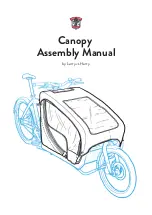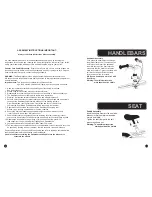
18
19
OWNER MANUAL
ATTENTION
: Once the power is switched on, if the rider twists the throttle the bike will lurch forward!
Do not turn the power on until you are ready to go.
The hand brake will automatically cut the power to the motor as
also will releasing the throttle. While starting or climbing a hill, pedal as much as possible, so that the electric power
will not be drained too much. At the same time, it can lengthen the life of the battery and motor.
ATTENTION
: When riding down hills, do not turn off the power, otherwise the controller and motor will be easily
damaged.
While running, if the battery power is getting low, the battery meter will go down. At this time you should pedal your
e-bike like a regular bike and charge the battery as soon as you get to an electrical outlet. Turn off the power while
parking. If you decide to push your bike for any reason, make sure to turn the power off, so you don’t accidentally turn the
throttle making the electric bicycle start suddenly and cause an accident. To help get the best distance out of your electric
bike, refrain from a lot of braking and coast as much as possible.
7
BATTERY CHARGING AND
PRECAUTIONS
Surface 604 lithium battery charger is purposely built for Surface 604. The label on the back side of the charger indicates
the input and output voltages. Please check the voltage with your local standard, and pay attention whether the output
voltage and plug are of the correct voltage rating and type.
At initial three charges, please charge the battery over 12 hours. If daily riding distance short, do not need to recharge
battery frequently;
It is important to charge the battery after every use. This will extend the total life of your battery. Once the charger
indicates that your battery is fully charged the green light will come on. Unplug the power source from the bicycle and the
electrical outlet and store in a cool, dry place. Do not leave the charger plugged into the battery for long periods of time as
this can damage the battery.
1. Turn off the display.
2. Insert plug of the charger into charging port of the battery box. You can charge your battery while still in the bike or
you can take it out of the bike and charge where it is most convenient.
3. Insert the charger into the wall outlet. Do not plug charger into outlet until you first plug the charger into the bat-
tery charging port. A red light will come on. It can take up to 12 hours to recharge the battery completely. On most
chargers, a green light will appear when it is fully charged.
4. When the light turns from red to green, it indicates that the battery is full. If possible, charge for an additional 2-3
more hours to fully charge the battery. After the green light comes on, the charger is in trickle charge mode. If you
will be gone for many hours, you should unplug the charger. This is especially true in hot weather. Avoid overcharg-
ing and damaging the battery. It is normal for a charger to become warm during charging, so keep charger away
from any flammable materials. You can also charge the battery when it is removed from the bicycle. This is espe-
cially convenient during cold nights or when your bike is not parked near an electrical outlet. Because specifications
of the charger may change in the process of production, please read the information on the charger itself or the
charger manual (if included) in detail before using. Always charge the bike in a dry, clean and well ventilated place.
5. If the red light on the charge indicator does not change color after a long period of charging (>12h), it is likely there
are some problems with the battery or charger. Please disconnect the charger to avoid overcharging battery. Take
the charger and battery pack to service center.
7.1
Battery precautions
•
Do not touch the poles of the battery with your hands when the battery is removed for charging. Also, the battery
poles should not be touched with any metal or other material that conducts electricity.
•
While charging, put the battery in a secure place where children can’t reach.
•
Do not use any charger other than the one that came with your GIO Electric Bike. If you ever do need to replace the
charger, contact your local dealer.
•
The electronics of your charger contain high-tech circuits, and you should therefore not attempt to open or
repair it.
•
Prevent liquids, metal and metal filings from permeating the charger, and be careful to not drop or hit the charger
which could cause damage.
•
Do not put anything on top of the charger or battery while charging. It must be well-ventilated to allow all the
heat generated to dissipate.
•
When charging, if there is a peculiar smell or the temperature is too high, please stop charging immediately.
•
To prevent premature failure of your battery and for your warranty to remain in effect on your battery, YOU MUST
CHARGE THE BATTERY AT LEAST EVERY 6-8 WEEKS. DO NOT use if the battery is almost depleted.
•
The charger might produce heat up to 185°F (85°C) in the course of using, so keep it away from flammable articles
while in use.
•
It is normal that the mileage capacity will reduce as a result of low temperatures.
•
While carrying the charger, DO NOT bump, drop, or damage, otherwise it may result in failure.
•
Avoid any contact with water when charging your battery. If a plug or socket gets wet, dry it completely before
using.
•
Do not leave the charger connected to the battery and the outlet for more than 14 hours.
•
Discharge half capacity to leave battery unused for longer periods of time.
•
Always use the charger according to the instructions.
•
If you frequently start up and stop or ride on rough terrain, the battery level indicator may go down quickly. It is
normal for the battery level indicator to go up after riding continuously for some distance.
7.2
Removing the battery from the bike
A. Turn off the battery.
B. Turn the key to release the locking pin (unlock).
C. Slide out battery from its position in the bike.
PULL
7.3
Installing the battery on the bike
A. Turn off the battery.
B. Slide in the battery to its position in the bike. Make sure the battery is slid into the rail.
PUSH
Rail































